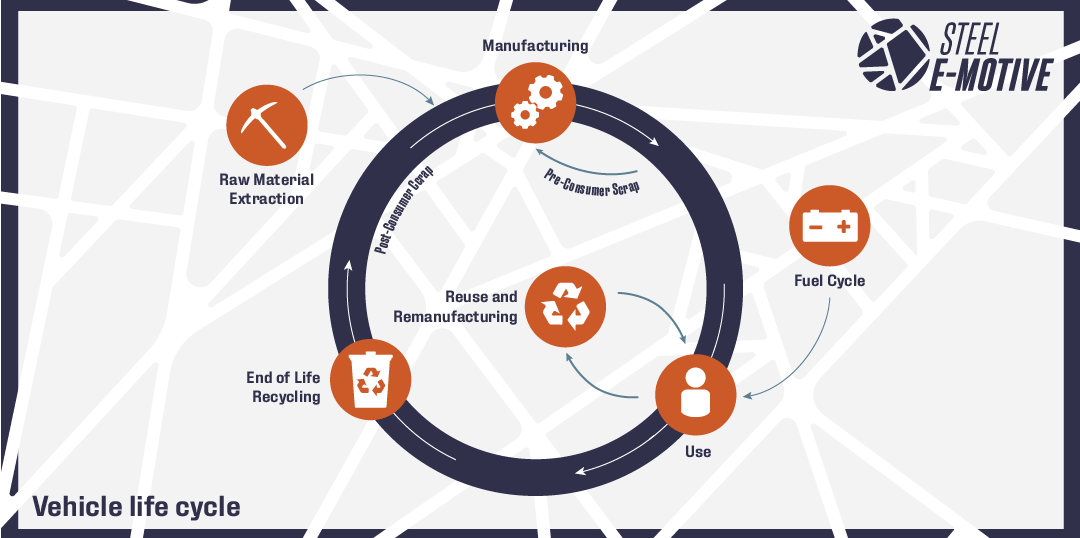A sustainable autonomous vehicle fit for purpose in a future mobility ecosystem
The Steel E-Motive project, commissioned by WorldAutoSteel in collaboration with UK-based global engineering and environmental consulting firm Ricardo, demonstrates the sustainable qualities of AHSS, through the creation of two virtual vehicle concept designs, for a ‘mobility as a service’ operating model. The team conducted a comprehensive life cycle evaluation of the Steel E-Motive concept, evaluating emissions impacts from the materials and manufacturing processes through the use-phase and on to final disassembly and recycling.
The findings helped drive a lot of the target achievements and strategic decisions for the Steel E-Motive vehicle designs, enabling the team to investigate and apply future technologies that will reduce CO2. This allowed for validation of Steel E-Motive vehicle sustainability credentials.
Steel’s constant evolution enables more efficient designs, thereby further minimising vehicle carbon footprint from a life cycle perspective. Steel’s inherent material characteristics are recognised around the world for their alignment with Circular Economy goals for use reduction, reuse, remanufacture and recycling.
Russ Balzer, Technical Director for WorldAutoSteel said the findings from Steel E-Motive’s Life Cycle Assessment show that:
“Advanced High-Strength Steels enable manufacturers and autonomous vehicle fleet operators to work towards achieving net zero greenhouse gas emissions targets because steel production has the lowest carbon footprint of all automotive structural materials.
Manufacturers and fleet operators of EVs operating in a mobility as a service model will get closer to achieving “net zero” emissions goals if the sustainability efficiencies designed into the Steel E-Motive concept vehicles are applied and AHSS is used as the dominant material.”
Environment & Sustainability: Comprehensive life cycle assessment and optimisation, demonstrating potential for 92% reduction in GHG (2020 vs 2035 scenario)


Manufacturing
Decarbonise steel production and optimise vehicle design, material utilisation and fabrication processes to minimise production emissions.

Fuel Cycle
HV battery production emission study and > 2030 forecast. Decarbonise electricity grid supply for xEV. Global variations & >2030 forecast (production and vehicle use).

Use
Real world drive cycle and drive cycle smoothing with autonomous vehicle control.

End of Life Recycling
Maximise Re-use, Re-manufacture, Recycling. End of life methodology.
Supporting the pathway to net zero
More countries are committing to net zero emissions targets by 2050. With transportation accounting for about 30% of emissions , it is important that future transportation solutions address this problem. Battery electric autonomous vehicles enable a step in the right direction towards lower emissions because tailpipe or use phase emissions are eliminated, provided they are designed and deployed in a way that encourages ridesharing in cities with high levels of traffic and pollution.
However, it’s not enough to simply look at reducing the operational emissions of these vehicles. Every product has a carbon footprint which spans the entirety of its life, from the production of raw materials right through the end of serviceable life.
Fit for purpose in a future smart city
The Steel E-Motive concept is fit for purpose in a future mobility ecosystem because it can help to achieve an overall reduction in GHG emissions. In the right context and alongside a range of other measures, emissions savings of up to 85% are achievable compared with existing EVs.
This is based on a comparison of a present-day battery electric vehicle and a Steel E-Motive vehicle operating a ride-hailing service in 2035. Given all the factors contributing to vehicle emissions, such as decarbonization of the electric grid, vehicle electrification, autonomy and rideshare vehicles operating at appropriate capacity, Steel E-Motive demonstrates that steel is fit-for-purpose for original equipment manufacturers and MaaS providers, enabling them to reach their sustainability and emissions goals.
A life cycle perspective
The Steel E-Motive program is using AHSS in the designs of two autonomous EVs to make a mobility solution that is sustainable across the full product life cycle. To achieve this the Ricardo team has applied a Life Cycle Assessment (LCA) approach to ensure that design decisions are contributing to a reduced total vehicle emissions footprint.

Smart design and engineering replace a lightweighting focus
As vehicle efficiency measures such as automation, electrification, and ridesharing are increasingly adopted, and as the grid used to charge EVs gets greener, the impact of lightweighting to reduce emissions during the use phase of EVs reduces. This makes it increasingly important to consider efficiency across the entire vehicle life cycle, including trade-offs between life cycle phases.
Steel E-Motive vehicle concepts have been designed with this efficiency in mind. The body structure is optimised to achieve a low weight, and advanced fabrication processes achieve high material utilisation (minimum scrap). These result in reduced carbon emissions in the production phase and more efficient operation during the use phase.
The batteries in EVs make a significant contribution to the overall vehicle production GHG emissions. The Steel E-Motive concept considers the impact of ongoing and future improvements in battery technologies and the reduction in GHG emissions that this enables.
Ricardo Chief Engineer on Steel E-Motive, Neil McGregor, handles the engineering aspect of the project ensuring all technical targets are delivered. He said:
“During the use phase of battery electric vehicles such as Steel E-Motive, the vehicle GHG emissions are dependent on the source of electricity used to charge the battery.
The life cycle calculations performed for the Steel E-Motive concept consider future forecasts and impacts for the decarbonisation of the electricity grid supply as the shift to “cleaner and greener” energy sources, such as wind and solar, increases.”
Regional variances in this shift to clean energy are considered, with calculations performed for Steel E-Motive vehicles operating in Europe, USA, China, Japan and India.
While many OEMs conduct LCA studies on their vehicles, the concept of designing vehicles with an LCA focus is new for most product designers. Designers must consider six key things when taking an LCA approach to vehicle development:
- Functional Equivalence
- Material utilisation
- Material emission impact
- Trade-offs between stages
- Re-use, Re-manufacture, Recycling
- Matching the LCA tool to the design stage
You can find out more about this here.
A new vehicle operating model to help cut emissions
Using the Steel E-Motive vehicle in a ‘mobility as a service’ operating model will result in increased vehicle occupancy, achieving a net reduction in vehicle journeys and a significant decrease in greenhouse gas and local pollution emissions.
Neil McGregor said:
“Fully autonomous, ‘Mobility as a Service’ vehicles by their nature enable further efficiency and GHG contribution savings. In addition, the route and speed of a vehicle that is digitally connected to other vehicles and road infrastructure (such as traffic lights and congestion monitoring), can be optimised to match the traffic conditions, resulting in less propulsion energy required compared to a driver-operated vehicle.”
Find out more
Two Mobility as a Service vehicle concepts are being developed as part of the Steel E-Motive project: a four-passenger variant for inner-city use and a larger six-passenger extra-urban variant that will service mid-length journeys, such as inter-city or city-to-airport runs. Both designs also can be adapted and used as a delivery vehicle. Steel E-Motive, unlike other future mobility concepts, has been designed to be fully compliant with the most stringent global crash standards. This level of design validation means a future prototype build is quite feasible, depending on industry interest and feedback.
Steel E-Motive engineering and validation is almost complete. You can learn more about our design progress by reviewing our updates. In 2023, the team will share design concepts and results globally. Stay on the Steel E-Motive journey with us as more engineering decisions and solutions will be revealed between now and the end of 2023.
Be sure to subscribe to stay in touch with webinars, technical publications, and conferences where we will present results information.
Subscribe for updates
You might also be interested in
